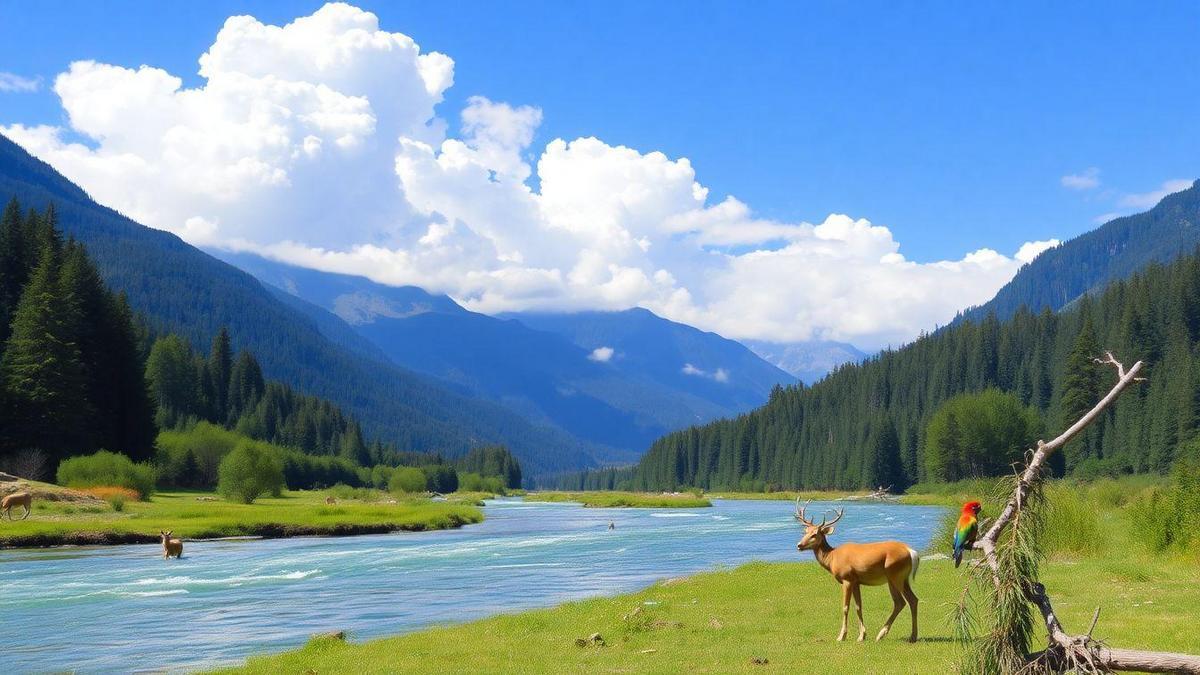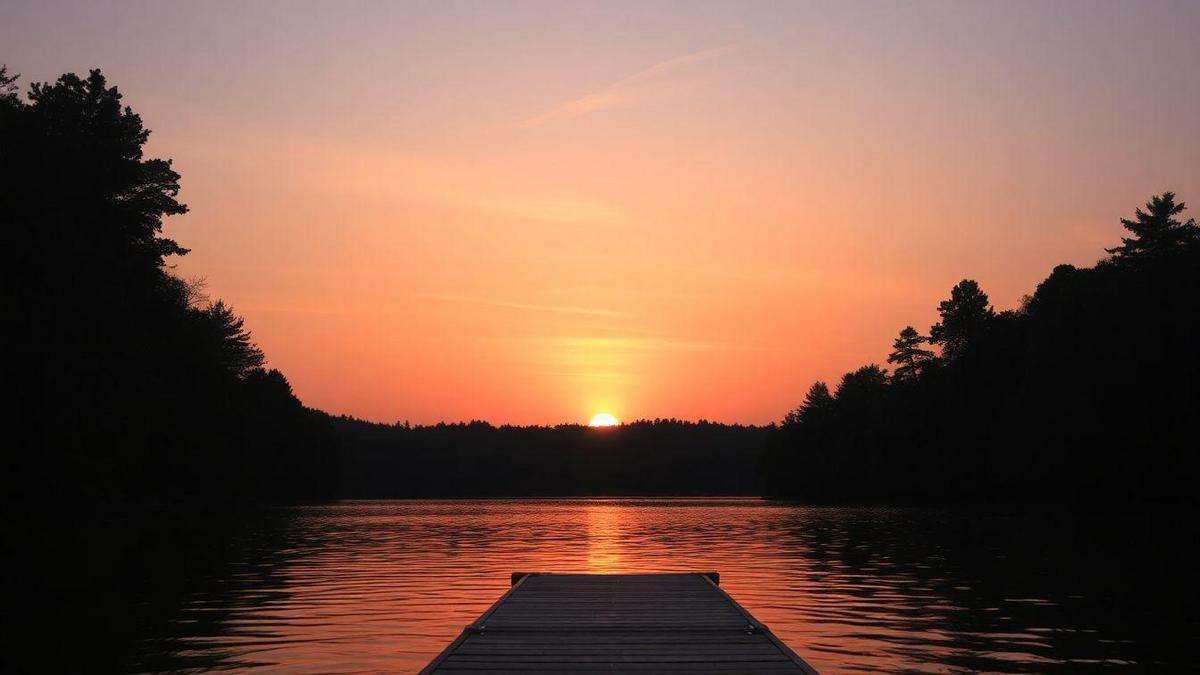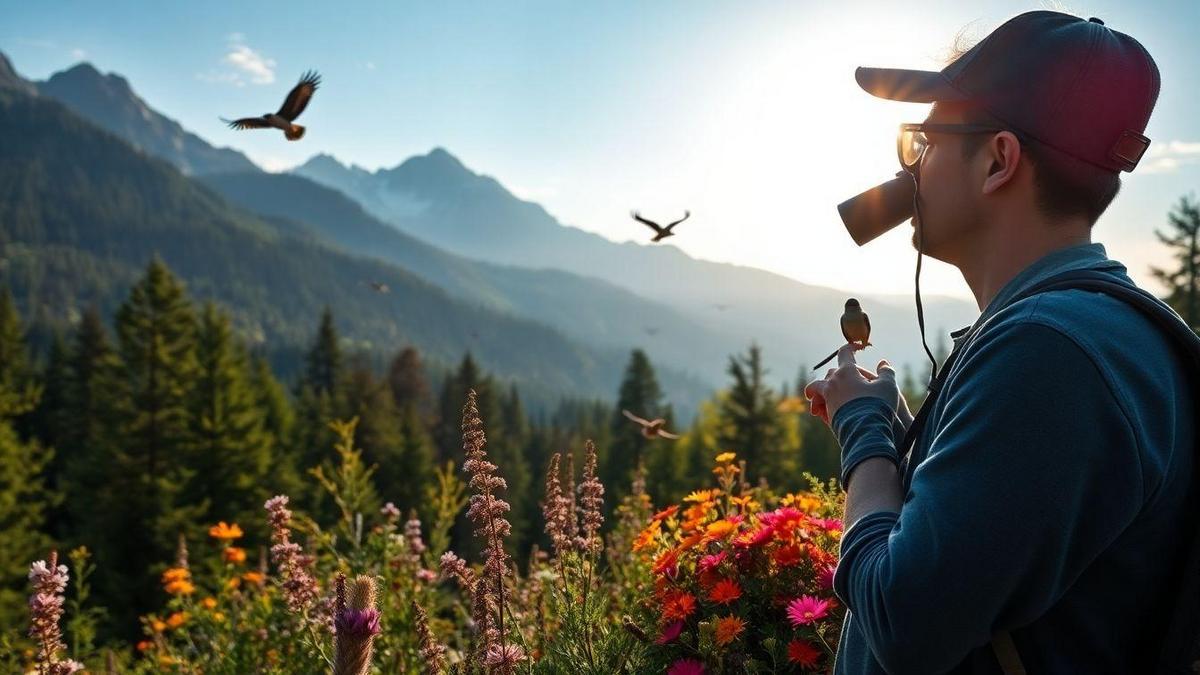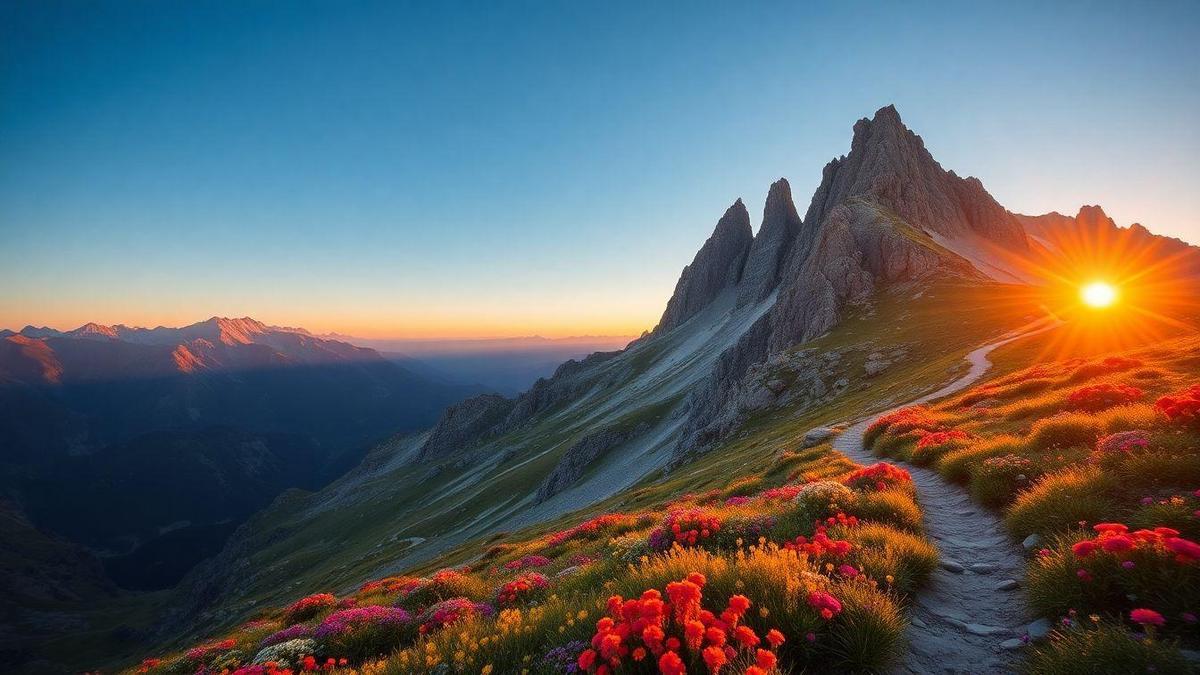
Discovering Scenic River Trails for Wildlife Viewing
Explore Trails with Unique Wildlife
When you venture out to the mountains, you’ll find scenic river trails that are perfect for spotting wildlife. These trails often wind alongside flowing rivers, creating a vibrant habitat for various animals. Imagine walking along a peaceful riverbank, with the sound of water splashing nearby, and suddenly spotting a deer drinking from the river.
Some trails, like the Riverside Trail in the Rocky Mountain National Park, are known for their rich wildlife. You might see bald eagles soaring overhead or otters playing in the water. Each trail offers its special charm, so take your time to explore and see what you can discover. For those looking for the best mountain wildlife watching opportunities, there are numerous spots to consider.
Best Times for Animal Sightings
Timing is everything when it comes to wildlife viewing. Early mornings and late afternoons are often the best times to catch a glimpse of animals. During these hours, animals are more active, searching for food or enjoying the cooler temperatures.
Here’s a quick guide to help you plan your trip:
| Time of Day | Best for Viewing |
|---|---|
| Early Morning | Deer, Foxes, Birds |
| Late Afternoon | Bears, Elk, Bighorn Sheep |
| Dusk | Beavers, Owls |
By going at these times, you increase your chances of seeing some amazing wildlife.
Tips for Enjoying Scenic River Trails
- Stay Quiet: Animals are easily scared away. Keep your voice down and move slowly.
- Bring Binoculars: This will help you see animals from a distance without disturbing them.
- Know the Area: Research the trails before you go. Some may have specific rules or best viewing spots.
- Pack Snacks: Keep your energy up while you explore. A little snack can make a big difference!
- Dress Comfortably: Wear sturdy shoes and dress in layers. You want to be comfortable while you enjoy nature.
Bird Watching Hotspots near Mountain Rivers
Identifying Local Bird Species
When you’re near mountain rivers, the chances of spotting local bird species are high. You might see eagles soaring above or kingfishers darting by the water. Each season brings different birds, so pay attention! Here are a few you might encounter:
- Bald Eagle: Look for this majestic bird perched on a tall tree or gliding over the river.
- Osprey: Often seen diving into the water for fish.
- American Dipper: This little bird loves to swim and can be spotted bobbing along the riverbanks.
Take your time to observe. The more you watch, the better you’ll get at identifying them!
Ideal Conditions for Bird Watching
To make the most of your bird-watching adventure, consider the best conditions. Early mornings are often the best time. Birds are most active at dawn, making it easier for you to spot them. Here are some tips to create the ideal bird-watching experience:
- Quietness: Keep your noise to a minimum. Birds are easily scared away.
- Weather: Overcast days can be great because birds are more likely to be out and about.
- Location: Choose spots near water. Birds love to gather where there’s food and shelter.
Tools to Enhance Your Bird Watching Experience
Having the right tools can make your bird-watching experience even better. Here’s a simple list of items to consider bringing along:
| Tool | Purpose |
|---|---|
| Binoculars | Helps you see birds from a distance. |
| Field Guide | A handy book to identify bird species. |
| Notebook | Jot down your observations and experiences. |
| Camera | Capture those special moments. |
These tools can help you enjoy your time by the mountain rivers even more. Remember, the joy of bird watching lies in the details!
Fishing Opportunities in Mountain Rivers
Types of Fish You Can Catch
When you cast your line into mountain rivers, you might be surprised by the variety of fish swimming below the surface. Some popular catches include:
- Trout: Rainbow, brook, and brown trout are common in these cool waters. For the best fishing spots, consider checking out areas known for their trout population.
- Bass: Largemouth and smallmouth bass can be found in some river sections.
- Pike: In certain areas, you might even hook into a northern pike.
- Salmon: Depending on the season, salmon can be a thrilling catch.
Each type of fish offers its own unique challenge and thrill. Imagine the excitement as you feel that tug on your line, knowing a lively trout is on the other end!
Regulations for Fishing in Natural Habitats
Before you head out, it’s essential to understand the rules around fishing in mountain rivers. These regulations help protect fish populations and maintain the health of the ecosystem. Here are some key points to keep in mind:
| Regulation Type | Details |
|---|---|
| Licensing | Most regions require a fishing license. |
| Seasonal Restrictions | Certain fish may only be caught during specific seasons. |
| Catch Limits | There are limits on how many fish you can keep. |
| Bait Restrictions | Some areas may restrict certain types of bait. |
Make sure to check your local fishing regulations before you go. Following these rules helps keep the rivers healthy for future generations of anglers.
Best Practices for Responsible Fishing
Fishing is not just about the catch; it’s also about being a good steward of the environment. Here are some best practices to follow:
- Catch and Release: If you’re not planning to eat your catch, gently release it back into the water.
- Use Barbless Hooks: These hooks make it easier to release fish without harm.
- Stay on Trails: Avoid trampling vegetation along riverbanks.
- Clean Up: Always pack out what you pack in. Leave no trace!
By following these practices, you help protect the beauty of mountain rivers and the creatures that call them home.
Eco-Tourism and Wildlife Viewing
Benefits of Eco-Tourism for Nature Enthusiasts
When you think of eco-tourism, you might picture breathtaking landscapes, fresh air, and the sounds of nature. For nature lovers like you, eco-tourism offers a chance to connect with the environment while enjoying incredible wildlife viewing opportunities near mountain rivers. Here are some key benefits:
- Sustainable Travel: You can explore beautiful areas without harming the environment. This helps keep nature thriving for future generations.
- Wildlife Encounters: Imagine spotting a majestic eagle soaring above or a playful otter splashing in the river. These experiences create lasting memories.
- Learning Experiences: Many eco-tours include knowledgeable guides who share insights about the local ecosystem. You’ll gain a deeper understanding of the wildlife and plants around you.
Supporting Local Conservation Efforts
By choosing eco-friendly tours, you’re not just enjoying nature; you’re also making a difference. Here’s how your choices can support local conservation:
- Funding Conservation Projects: Many eco-tourism companies contribute a portion of their profits to conservation efforts. This helps protect habitats for animals and plants.
- Community Involvement: Eco-tours often involve local communities, providing jobs and promoting sustainable practices. You’re helping families thrive while preserving nature.
- Awareness Raising: Your participation in eco-tourism helps raise awareness about environmental issues. Sharing your experiences can inspire others to respect and protect nature.
How to Choose Eco-Friendly Tours
Finding the right eco-friendly tour can feel overwhelming, but it doesn’t have to be. Here’s a simple guide to help you make informed choices:
| Criteria | What to Look For |
|---|---|
| Certifications | Look for tours with eco-certifications. |
| Local Guides | Choose tours led by local experts. |
| Small Group Sizes | Opt for tours with fewer participants. |
| Sustainable Practices | Check if they use eco-friendly materials. |
| Community Support | Ensure the tour supports local initiatives. |
By following these criteria, you can find a tour that aligns with your values and enhances your experience in nature.
Outdoor Adventures Beyond Wildlife Viewing
Activities to Pair with Wildlife Viewing
When you’re out in nature, especially near mountain rivers, there’s so much more to do than just watch the wildlife. You can dive into a world of adventures that will make your day unforgettable. Here are some fun activities you can enjoy alongside your wildlife viewing:
- Hiking: Explore the trails that wind through the mountains. Feel the fresh air and hear the rustling leaves. For the best hiking trails, consider those that are scenic and provide ample wildlife viewing opportunities.
- Fishing: Cast a line into the river and see what you can catch. It’s peaceful and exciting at the same time. Check out ideal fishing spots in mountain rivers for anglers seeking trout.
- Kayaking: Paddle down the river and get a different view of the landscape. You might spot some wildlife along the way! Popular kayaking routes in mountain rivers can enhance your adventure.
- Photography: Capture the beauty of the mountains and rivers. Whether it’s a stunning sunset or a bird in flight, your camera can tell the story. Don’t miss the top photography spots in mountains with rivers for breathtaking landscapes.
Safety Tips for Outdoor Adventures
While you’re having fun, it’s important to stay safe. Here are some essential safety tips to keep in mind:
- Stay Hydrated: Always carry water with you. It’s easy to forget when you’re having a blast, but your body needs it.
- Tell Someone Your Plans: Let a friend or family member know where you’re going and when you plan to be back. This way, they can help if something goes wrong.
- Be Aware of Your Surroundings: Keep an eye out for wildlife. Remember, you’re in their home, so respect their space.
- Dress Appropriately: Wear layers and sturdy shoes. The weather can change quickly in the mountains.
Planning a Fun Day in Nature
To make the most of your day, a little planning goes a long way. Here’s a simple table to help you organize your adventure:
| Time | Activity | Notes |
|---|---|---|
| 8:00 AM | Arrive at the location | Set up a base camp |
| 9:00 AM | Start hiking | Choose a trail suitable for you |
| 12:00 PM | Lunch by the river | Pack a picnic from unique picnic areas by mountain rivers |
| 1:00 PM | Wildlife viewing | Bring binoculars |
| 3:00 PM | Fishing or kayaking | Check local regulations |
| 5:00 PM | Wrap up and head home | Take your time to enjoy the sunset |
By planning your day like this, you can enjoy all the wildlife viewing opportunities near mountain rivers for nature enthusiasts while ensuring you have a blast!
Understanding Natural Habitats of Mountain Rivers
Importance of River Ecosystems
Mountain rivers are like the lifeblood of their surroundings. They nurture the land, providing water for plants and animals. These rivers help shape the landscape, creating valleys and canyons. They also support fishing, which many communities rely on for food and income. Without these rivers, the ecosystem would struggle to thrive.
How Habitats Support Diverse Wildlife
The habitats around mountain rivers are crucial for many species. Birds, fish, and mammals all call these areas home. For example:
- Bald Eagles often nest near rivers to hunt for fish.
- Otters play in the water, showcasing their playful nature.
- Deer come to drink, finding safety in the nearby trees.
These habitats provide food, shelter, and breeding grounds. The rivers create a network that supports life in various forms.
Ways to Protect Natural Habitats
Protecting these habitats is essential for the health of our environment. Here are some simple ways you can help:
- Reduce Pollution: Keep trash and chemicals away from rivers.
- Plant Trees: Trees help prevent soil erosion and provide shade for wildlife.
- Support Conservation Efforts: Join local groups that work to protect river ecosystems.
- Educate Others: Share what you know about the importance of mountain rivers.
By taking these steps, you can help maintain the beauty and health of mountain rivers and their surrounding habitats.
Frequently Asked Questions
What wildlife can I see near mountain rivers?
You can spot deer, elk, and a variety of birds. Sometimes, you might even see a moose! Keep your eyes open.
When is the best time for wildlife viewing near mountain rivers?
Early mornings or late afternoons are the best times. Wildlife is more active during these hours. You want to plan your trip around that!
Do I need special gear for wildlife viewing near mountain rivers?
A pair of binoculars is great to have! Also, wear comfortable shoes and clothes. This way, you can enjoy your adventure more.
Are there guided tours for wildlife viewing near mountain rivers?
Yes! Many parks offer guided tours. This can help you learn more about the animals and where to find them.
How can I be respectful of wildlife when viewing near mountain rivers?
Stay a safe distance away from animals. Don’t feed them or disturb their homes. Respecting wildlife keeps both you and the animals safe.


